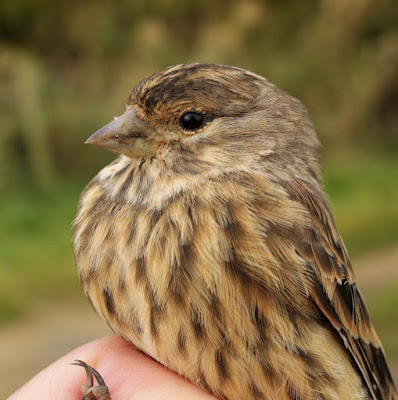It’s not often our west coast weather allows two consecutive days of ringing, and hardly ever three days in a week. But this week, and after pushing our luck through marginal forecasts we managed Monday, Thursday and Friday – amazing!
So after the last post, here’s the summary for Thursday and Friday rolled into one as the mornings were similar or the same in location, weather conditions, species and numbers.
Our consecutive mornings of Thursday and Friday realised a total of 42 birds - 25 Linnet, 3 Greenfinch, 2 Redwing, 2 Reed Bunting, 2 Pied Wagtail, 1 Song Thrush, 1 Dunnock, 1 Wren, 1 Goldcrest, 1 Robin, 1 Blackbird, 1 Great Tit, 1 Blue Tit.
We caught our first Redwings of the autumn, together with migratory Song Thrush and Blackbird.
Song Thrush
Redwing
The Skylark theme of Monday continued throughout the mornings of Thursday and Friday with many more Skylarks passing over in their north to south path to take our count for the three mornings to several hundred individuals. This has been a phenomenal and most unusual occurrence to take place over this essentially narrow corridor of coastal Lancashire known as Fylde. We simply cannot be sure of the Skylarks’ start points, but almost certainly Scotland.
Although a good number of the Skylarks showed a high level of interest in a recording of their songs and calls we had no luck with tempting any into a whoosh net catching area.
Instead of Skylarks we caught a couple of Pied Wagtails with the whoosh net, both birds first year males.
Thursday and Friday saw another 25 Linnets ringed with zero recaptures from this or any other year. A good number of the latest Linnets are of Scottish origins. We know this because Linnets from Scotland invariably have the very blackish streaked heads not seen in typical cannabina forms of English Linnets. Alongside that we are also seeing slightly longer winged males of 83, 84 and 85mm.
The odds and ends of sightings/birds from Thursday or Friday seem insignificant when laid alongside the Skylark migration of the week.
Thursday - 28 Whooper Swan, 1 Kingfisher, 2 Buzzard, 1 Sparrowhawk, 5 Reed Bunting, 20 Swallow, 80+ Skylarks.
Friday - 4 Blackbird, Stonechat, Cetti’s Warbler, Swallow, Great-spotted Woodpecker, Kestrel, Mistle Thrush, 30+ Long-tailed Tit, 140+ Skylark.
We rather hoped to catch the Cetti’s Warbler singing from
first light and periodically throughout the morning. However, both male and female Cetti’s are known to sing
so we can only assume that Friday’s bird was the same one as caught on Monday
last, a female, a few days later and already adept at avoiding bird ringers' mist nets.
Let’s keep an eye on the weather again! It’s looking like the weekend days will be spent at home with a pencil mark in the diary for Monday/Tuesday.
Keep in touch my friends.
Linking this weekend to Anni in Texas and Eileen's Saturday.








.jpg)


.jpg)

















.jpg)




.png)













































